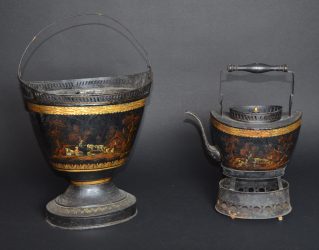
Kettle and Coal Scuttle
Date Undetermined
Toleware
Manufacturer unknown
JJ.1958.457
This kettle and scuttle are examples of toleware.“Tole” derives from the French tole peinte, which translates to “painted sheet metal.” Toleware is made with tinned metal that has been varnished to resist rusting; a process sometimes called japanning. Toleware was produced from circa 1700 to 1900. In 19th Century New England, toleware was made and painted by individual tinsmiths. There was a revival of toleware’s popularity in the mid-20th Century for the decorator market. The condition of these objects indicates an earlier date.
Kettles were used to heat water for tea. The elevated stand allowed use of a small oil or kerosene burner under the kettle. Traditionally, there is a difference between tea kettle and tea pot. Water was heated in kettle. Tea leaves were placed in pot, and the hot kettle-water was added. Tea was served from the pot, not from the kettle.
Scuttles were used to keep a supply of coal close at hand in a kitchen, or in any room heated by a fireplace. After the Industrial Revolution, coal replaced wood as household fuel in England. Coal came to use in North America slowly, starting in late 18th Century. Scuttles became popular in England during Victorian period. They were often designed with a shaped pouring spout to facilitate adding coal to a fire. This scuttle lacks that design feature. An accessory scoop or small shovel probably was used.
By the time of William Jay’s (1789-1858) ownership of the house, coal would have been available as a heating and cooking fuel. After War of 1812 cut supplies of British bituminous (soft coal), anthracite (hard coal) fields in northern Pennsylvania were opened to production. Coal has several advantages over wood as a fuel: one pound of hard coal provides as much heat as 1 ½ cords of hardwood; Coal can be kept outside and is “weatherproof;” coal does not have to be felled, sawn or seasoned; and a coal fire typically will burn for 12 hours, without need for frequent refueling.
You may view the Object of the Day Archives HERE
